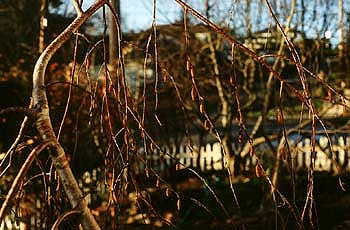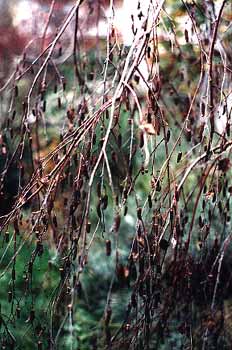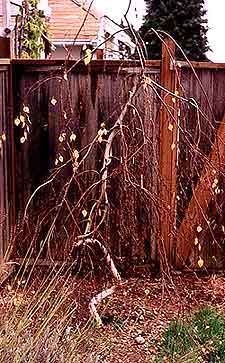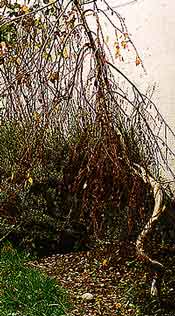
|
Young's |
Young's Weeping Birch (Betula pendula 'Youngii') is a variety of the European white birch. It is shown at the left in mid-December (2002) with the majority of its leaves gone & its endearing three-inch catkins hanging all about it's slender branches.
The catkins are shown again in the second photo, snapped in January (2003). They last all winter & then burst into fuller glory in the springtime, when the female flowers appear on the same branches, small & brown & almost fir-cone-like.
Young's Birch has no central leader & if permitted to retain it's fountaining disposition, & with some carefully considered annual pruning, it can remain artificially dwarfed in the six to twelve foot range.
 On the other hand, if a branch is selected as a leader & trained upward by staking it to a long bamboo pole, it will develop a sturdy upright trunk. In that case the tree can reach 45 feet & not inconceivably twice that.
On the other hand, if a branch is selected as a leader & trained upward by staking it to a long bamboo pole, it will develop a sturdy upright trunk. In that case the tree can reach 45 feet & not inconceivably twice that. We are counting on it remaining dwarfed & hope it doesn't fool us on that score, as it has a position that could obscure a window-view of Sinclair Inlet & Mount Rainier if it got too big. If a few limbs do eventually reach up into the view that'll be fine, as even in full leaf it is not as thickly leafed as most birches.
Some people worry that birches will get into water pipes, but this is not at all likely with the Young's weeping birch's shallow root system, & they are quite safe near concrete ponds.
Eminently trainable, ours was obtained as a mature dwarf that had been pot-raised & tortured into an unusual trunk shape. Or, rather, three trunks were wound about one another & tortured, having fused into a single trunk with only hints of having once been three.
Some people plant this tree in a smallish patio area since it can be restrained from outgrowing a space, though it certainly can develop a wide fountaining circumference if left to its own devices. Ours has a natural lean to it, so we planted it in a garden corner tilted into a clearing where we most wanted its branches to dangle.
 The third photo was taken in November 2002, with some of the autumn-yellow leaves still attached. Earlier in November it is much fuller of yellow leaves, as can be seen on the Weeping Birch Page of the Autumn Trees Gallery.
The third photo was taken in November 2002, with some of the autumn-yellow leaves still attached. Earlier in November it is much fuller of yellow leaves, as can be seen on the Weeping Birch Page of the Autumn Trees Gallery.It holds its autumn leaves a surprisingly long while, plus it will be one of earliest trees to return to full leaf. It develops the brown blossoms quite early in spring, too; despite a subdued color the flowers are quite showy. I've added another page of photos of the Young's Weeping Birch's Spring Appearance, including the charming flowers.
A fourth photo (on right) was taken the same day in November, from the other side of the tortured trunk. It has startling white bark with black fissures, appealing year-round. Some of the bark acquires orange-yellow hues at the height of winter, as can be seen on the Young's Weeping Birch Page along the Winter Bark Garden Walk.
 Birches have a reputation for short life in gardens, a scant 15 to 25 years, & Young's weeping birch can be more delicate than average. But in fact birches can be considerably long-lived in ideal conditions which, alas, are not always easy to duplicate in yards. Though it likes good deep weekly waterings, it is by no means the bog tree some people seem to mistake it for, & its life is shortened in clay or in any poorly draining soil. Even just dead center in a flat yard is apt to drain insufficiently, so a hillside or near a cliff would be preferable.
Birches have a reputation for short life in gardens, a scant 15 to 25 years, & Young's weeping birch can be more delicate than average. But in fact birches can be considerably long-lived in ideal conditions which, alas, are not always easy to duplicate in yards. Though it likes good deep weekly waterings, it is by no means the bog tree some people seem to mistake it for, & its life is shortened in clay or in any poorly draining soil. Even just dead center in a flat yard is apt to drain insufficiently, so a hillside or near a cliff would be preferable.Furthermore, it has a peculiar sunlight requirement, in that it does like a good deal of sun for its leaves, but not on its roots or below the crown. The root system is shallow & bakes under soil or sod if sunlight hits around the base of a birch. Weeping varieties attempt to shade their own root systems, but the Young's has less dense leafing than others, so cannot always protect its own roots sufficiently.
If the precise needs can be met, the tree can last 50 to 80 years. The position we selected is west of a tall fence, so that its leaves receive direct morning to noon sunlight, but the base of the tree is in shade through much of the morning. There's also a sheer drop-off near this location & the soil drains extremely well. Barring attack by birch-borers to which it is susceptible, the location we chose should serve this tree for a long life.
With its potential delicacy in mind when we first planted it, we spiked the soil with beneficial fungus. Pruning is done in autumn or in summer; it's slender dangling twigs lose too much sap if trimmed in spring with the possibility of the branch tips drying out & becoming dead wood, so it is best not to prune in spring.
Excessive pruning (more than a fifth of the overall branching) or pruning in the wrong season can set this tree up for insect attacks. Keeping an eye on it for insect trouble is important, but if all other conditions are really favorable, & the tree lives without stress, it is not going to be the first birch the borers or the leaf miners seek. There are, however, some places along the eastern seaboard where nobody even tries to grow weeping birches because borers are far too likely to arrive.
Birches by & large do not require much in the way of fertilizer & when fertilizing is done, it should be only for soil correction, & with slowest release feeds, or thin surface coatings of well-composted manure which is nearly inert hence not too rich for this tree's liking. The Northwest's naturally rich & acidic soil is just what it likes.